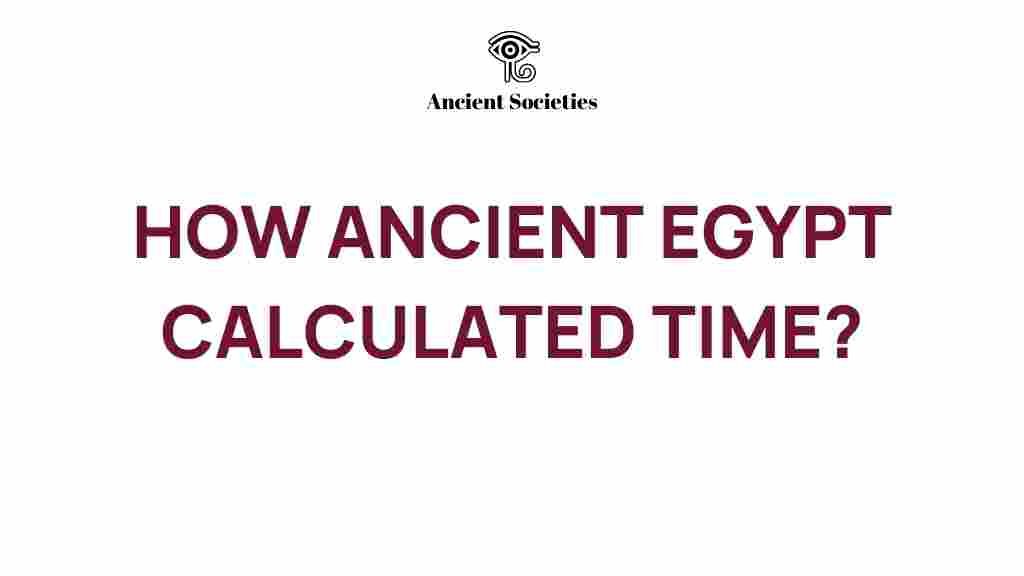Unveiling the Secrets of Ancient Egypt’s Timekeeping Methods
Ancient Egypt is a civilization that has long fascinated historians and archaeologists alike. Known for its monumental architecture, rich culture, and innovative practices, one of the lesser-known yet equally intriguing aspects of this civilization is its timekeeping methods. Timekeeping in Ancient Egypt was not merely about measuring hours; it was intricately linked to their calendars, astronomy, and societal structure. In this article, we will explore the various timekeeping methods utilized in Ancient Egypt, including sundials and water clocks, and how these innovations reflect the culture and history of this remarkable civilization.
Understanding the Importance of Timekeeping in Ancient Egypt
In Ancient Egypt, timekeeping was essential for various reasons:
- Agricultural Planning: The Nile’s flooding cycle was crucial for agriculture, and accurate timekeeping allowed for better planning of planting and harvesting.
- Religious Observances: Many religious festivals and rituals were tied to specific times of the year, necessitating precise calendars.
- Social Organization: Timekeeping helped in organizing labor, trade, and daily activities within the community.
The Egyptians developed sophisticated methods to track time, which were rooted in their observations of natural phenomena, particularly the movement of celestial bodies.
The Evolution of Timekeeping Methods
Ancient Egypt’s timekeeping methods evolved over millennia. The primary tools they utilized included:
Sundials
Sundials were one of the earliest timekeeping devices used by the Egyptians. They operated on the principle of casting a shadow from a gnomon (a vertical stick or pillar) on a flat surface marked with hour lines.
- How Sundials Worked: As the sun moved across the sky, the shadow of the gnomon would fall on different hour lines, indicating the time of day.
- Limitations: Sundials were effective only during daylight and could not be used during cloudy days or at night.
Water Clocks
Water clocks, also known as clepsydra, were another innovative timekeeping method used in Ancient Egypt. These devices measured time by the flow of water from one container to another.
- Design: Typically, a water clock consisted of a large bowl with a small hole at the bottom. Water would drip out at a consistent rate, marking the passage of time.
- Usage: Water clocks were particularly useful for measuring time during the night or on cloudy days when sundials were ineffective.
The Role of Astronomy in Timekeeping
Astronomy was deeply embedded in the culture of Ancient Egypt and played a crucial role in their timekeeping methods. The Egyptians closely observed the stars and celestial events to create their calendars.
Creating Calendars
The Ancient Egyptians developed a calendar system based on lunar and solar cycles:
- Lunar Calendar: Initially, they used a lunar calendar consisting of 12 months of 30 days each, with an additional 5 days added at the end of the year.
- Solar Calendar: To align with the solar year, they eventually adopted a solar calendar that consisted of 365 days. This was vital for agricultural activities and flood predictions.
This dual calendar system highlighted the Egyptians’ advanced understanding of time and its relation to natural cycles.
Innovations in Timekeeping and Their Cultural Impact
The innovations in timekeeping methods were not merely practical; they had profound cultural implications:
- Religious Significance: The precise measurement of time allowed for the scheduling of religious events, which were integral to Egyptian culture.
- Architectural Alignment: Many temples and pyramids were constructed with astronomical alignments, reflecting the importance of celestial bodies in their timekeeping.
- Record Keeping: Timekeeping enabled the Egyptians to maintain records of events, which contributed to their rich historical legacy.
Step-by-Step Process of How Timekeeping Worked in Ancient Egypt
Understanding how timekeeping worked in Ancient Egypt can be broken down into several key steps:
1. Observation of Celestial Bodies
The Egyptians began by observing the movements of the sun, moon, and stars. Their knowledge of astronomy was foundational to their timekeeping methods.
2. Development of Sundials
They created sundials to measure daytime hours. The positioning of the gnomon and the hour lines was carefully designed based on their geographical location.
3. Construction of Water Clocks
For nighttime and cloudy conditions, they constructed water clocks. The design ensured a consistent flow of water, allowing for accurate time measurement.
4. Creating Calendars
Through their observations, they developed a dual calendar system that facilitated agricultural and social planning.
5. Integration into Daily Life
Timekeeping became integrated into all aspects of life, from agriculture to religious practices, reflecting its critical role in their civilization.
Troubleshooting Common Issues
Although the timekeeping methods of Ancient Egypt were innovative, they were not without challenges. Here are some common issues and their solutions:
1. Inaccurate Sundial Readings
Issue: Cloudy days or obstructions could lead to inaccurate readings.
Solution: Use water clocks as a backup during such conditions to maintain accurate time measurement.
2. Water Clock Malfunctions
Issue: Blockages in the hole could disrupt the flow of water.
Solution: Regular maintenance and cleaning of the water clock components ensured smooth operation.
3. Calendar Adjustments
Issue: The calendar did not align perfectly with the solar year.
Solution: Periodic adjustments and the addition of intercalary days were necessary to maintain alignment with the seasons.
Conclusion
Ancient Egypt’s timekeeping methods reveal much about their civilization’s culture, history, and innovation. The use of sundials and water clocks, combined with their advanced understanding of astronomy, allowed the Egyptians to develop sophisticated calendars that were integral to their agricultural and religious practices. As we continue to study this incredible civilization, we uncover not only their achievements in architecture and art but also their remarkable advancements in timekeeping.
For more information on Ancient Egypt and its fascinating history, check out this comprehensive resource here. If you’re interested in exploring more about timekeeping in different cultures, you can find relevant information here.
This article is in the category History and created by AncientSocieties Team
